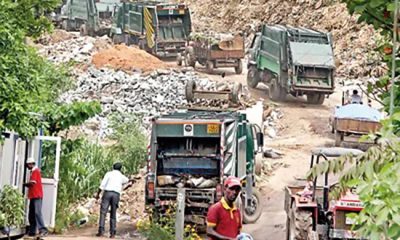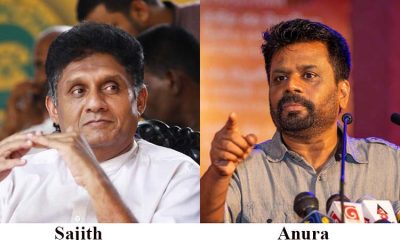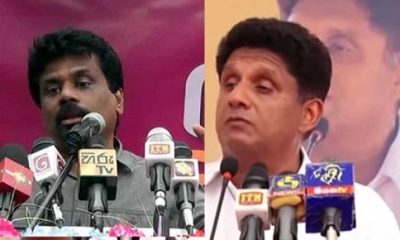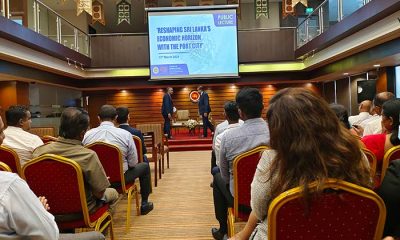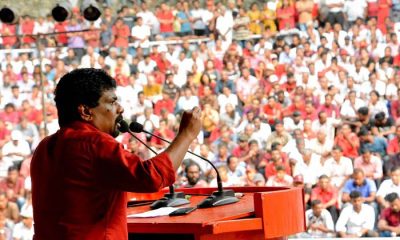Opinion
Debate or no debate, addressing critical issues important for voters

by Gamini Jayaweera
In recent weeks, we have observed a disheartening spectacle unfold between the Samagi Jana Balawegaya (SJB) and the JVP-led National People’s Power (NPP) as they engage in a futile tussle, each blaming the other for the failure to arrange a debate between their respective leaders and economic policy teams. This debate, crucial for enlightening the voting populace ahead of both the Presidential and General elections, remains elusive due to the entrenched animosity between the parties.
Consequently, the electorate grapples with disillusionment and disenchantment, triggered by the pervasive negative posturing exhibited by these factions, all while professing to champion system change and advocate for a governance model marked by inclusivity and transparency.
Both party leaders exude an air of unwavering confidence, believing they possess the panacea for our nation’s longstanding woes — be it the chronic mismanagement of the economy, the bloated and inefficient public sector, the archaic and dysfunctional constitution, the ailing healthcare system, the dilapidated state of education, or the pervasive corruption staining our political landscape and workforce. Yet, despite their professed solutions, they balk at the opportunity to engage in a substantive debate, opting instead for recycled rhetoric hailing their past ministerial achievements as the ultimate testament to their capabilities.
It begs the question: if they deeply hold the keys to resolving these entrenched issues, why shy away from a platform that could elucidate their strategies and policies for the benefit of undecided voters? As they bask in the glow of favourable poll numbers and draw sizable crowds to their political rallies, it becomes imperative to scrutinise their positions on critical matters. Therefore, I have taken it upon myself to pose several pressing questions, hopeful that the responses from these leaders will empower our electorate to make informed decisions come election day.
Economic Reforms
The promises of providing food for the impoverished, lowering essential commodity prices, ensuring equitable education, and universal healthcare are praiseworthy. However, the glaring question remains: how do they intend to finance these initiatives in the short term? Both parties have criticised current tax policies, labelling them unjustifiable burdens on the populace.
If elected, how do the NPP and the SJB plan to fill the revenue gap created by abolishing these taxes? Moreover, what strategies will they employ to stimulate economic growth and attract local and foreign investments? What specific details on their proposed policies and initiatives would provide voters with a clearer understanding of their economic reform agendas?
Public Sector Reform
It is evident that the public sector is bloated and inefficient, draining taxpayer funds without delivering commensurate value. Bold restructuring is necessary to curb waste and instil accountability. Yet, such reforms inevitably entail job losses. How do the SJB and the NPP propose to restructure these institutions while mitigating the impact on workers?
How will the administration ensure that displaced workers are effectively supported through redeployment, comprehensive redundancy packages, or access to retraining programs for alternative career pathways? Moreover, in the case of redeployment, where will these individuals find available vacancies and which industries will offer opportunities for retraining? Additionally, how will the necessary funds be allocated to ensure substantial redundancy packages for those affected by workforce transitions?
Administrative Service
The Sri Lanka Administrative Service (SLAS) comprises trained professionals, adept at government procedures. They collaborate closely with the President, the Prime Minister, and Ministers to formulate and execute policies, maintaining political neutrality and upholding SLAS integrity.
However, recent years have seen a decline in SLAS professionalism and integrity due to appointments based on political connections rather than merit. Can the NPP and the SJB commit to reversing this trend by appointing qualified SLAS officers to Secretarial positions in the ministries?
Diplomatic Service and International Relations
The image and reputation of a country rely heavily on competent diplomats who advocate for its interests globally. Historically, skilled diplomats have upheld our nation’s dignity and earned respect through responsible and professional representation in international relations.
Regrettably, recent appointments within the Foreign Service have often prioritised personal connections and political affiliations over merit. This neglects career diplomats and well-trained civil servants, leading to a decline in our international standing. Can the NPP and SJB assure they will not perpetuate this trend?
Public Sector Procurement Process
In 2017, the then President grimly revealed that over 50% of Sri Lanka’s public procurement contracts were tainted by the insidious grip of bribery and corruption. Shockingly, despite this alarming disclosure, successive governments, including the current administration, have regrettably fallen short in instituting the requisite measures to combat this pervasive menace, which continues to corrode the very fabric of our society.
The woeful underperformance of certain state institutions can be attributed to a myriad of factors. On one hand, these organizations suffer from a glaring absence of vision, transparency, accountability, and efficient systems and procedures. On the other hand, they turn a blind eye to the imperative of corporate governance, as rampant corruption infects the procurement process of public contracts and fosters a culture of unethical conduct. Furthermore, a dearth of business acumen at the leadership echelon has only exacerbated the lacklustre performance exhibited by most of our state institutions.
What are NPP and SJB proposals to implement a transparent public sector Procurement Process to ensure that the government is getting value for taxpayers’ money?
Public Sector Car Permits
It is widely acknowledged that certain professional groups in our society receive exclusive benefits from the government, including free car permits for vehicle imports and reserved placements for their children in prestigious government schools. The rationale behind these privileges raises questions: why are these groups afforded special treatment that is not extended to other government sector employees? Is it because they possess significant industrial influence, capable of exerting considerable pressure on the government through strike actions? Shouldn’t the government prioritise valuing the contributions of all its employees equally?
Trade Unions
Trade unions wield considerable influence in our society, often resorting to strikes as a means of protest. While legitimate grievances deserve to be addressed, politically motivated se the nation. What measures will the parties introduce to ensure that trade unions act responsibly and transparently? Could the NPP and the SJB potentially implement Trade Union laws requiring strikes to undergo democratic balloting, along with mandated clear notice periods aimed at minimizing disruption?
Pension Reform of Parliamentarians
The issue of full pensions for ministers and MPs after a mere ten years of service raises questions of fairness and equity. How do the parties plan to address this disparity and align the pension schemes of public servants with those of other citizens?
Dual Citizenship
The prohibition on dual citizens holding positions of responsibility within the government sector restricts the talent pool available to enact meaningful change. They are gathering in thousands for political meetings organised by the NPP. If so, what reforms will NPP and SJB propose to tap into the expertise of the overseas community while safeguarding against corruption and political interference?
Port City
The creation of a 25-year Tax Holiday zone with other incentives, called Port City within Sri Lanka to encourage foreign investors is under severe criticism from opposition parties due to many reasons. Reports suggest the introduction of a distinct tax system in the Port City, diverging from the national tax framework in Sri Lanka. This development raises concerns about the potential adverse effects of a dual tax system, including the demotivation of the workforce and economic inefficiencies. Considering these concerns, what proposals are being considered by the SJB and the NPP to reform this disparate tax structure and ensure uniformity across the country’s tax regime?
I understand that despite the proposed 25-year tax holiday, foreign investors are hesitant to participate in the scheme. It appears that as of now, there have been no tangible investments made by foreign entities in the Port City. How do you plan to ensure the success of this project, or will you allow it to languish as another ‘White Elephant’ doomed to inevitable failure?
Constitutional Reforms
The Executive Presidency and the Proportional Representation electoral system have been criticised by many politicians as well as the public for increased corruption and political favouritism compared to the introduction of the current system with the previous electoral system which operated prior to 1978.
During a rally in Sweden, the leader of the NPP party passionately advocated for Proportional Representation, emphasing its role in allowing minority communities to have their voices heard in Parliament. He argued that ensuring adequate representation from minority groups is crucial for fostering peace and harmony among diverse communities. However, this argument appears weak when considering the reality that major political parties like NPP, SJB, UNP, and SLPP often fail to provide opportunities for minority leaders to emerge within their ranks.
By neglecting to cultivate leadership from minority communities, these parties effectively bar individuals from those backgrounds from ascending to the positions of President or Prime Minister. It is worth noting that parties such as the NPP and the SJB could learn from examples set by the Conservative Party in the UK and the Democratic Party in the USA, both of which have seen leaders of Indian and African origin rise to the positions of Prime Minister and President, respectively. The question then arises: why hinder the possibility for a Tamil, a Muslim, or any member of another community to lead your party? Do you believe it would be beneficial to reduce sectarian voting by encouraging minorities to hold prominent positions within the major political parties?
Will your party commit to abolishing the Executive Presidency if elected to form the next government? Additionally, do you pledge to fully implement the 13th Amendment to the Constitution, thereby granting Provincial Councils comprehensive powers, including control over the police force? During a rally in Canada, when asked these crucial questions, the leader of the NPP evaded providing a clear answer, suggesting that it was not an immediate priority. However, it is vital for voters to have this information before casting their democratic ballots in the upcoming election.
Judiciary
It is a well-known factor that some of the Judges and the President Counsel have been appointed by the governing party based on political affiliations rather than the qualifications, experience, and suitability of the person to those positions. What are your proposals to introduce reforms in this area to ensure that the Judiciary is free from making politically motivated decisions and it will be free from political interference?
Appointment of Heads of Forces
There have been plenty of criticism, arguments, and accusations about appointing Heads for the three Forces. What Proposals do you have to ensure that those selections are done by independent Commissions attached to these Forces and the appointments are made on the recommendations by these commissions?
Environment
During the last few decades Politicians, Businessmen and Party supporters have been given the permission to clear out well established forests and other green sites and build commercial properties such as tourist hotels, golf courses, etc. These construction sites have destroyed the natural habitat making the weather patterns behave in strange ways. What are your proposals to protect our forests and the natural habitat from corrupt businesspeople, political henchmen, and politicians?
Conclusion
In conclusion, the voting public deserves clarity and accountability from those vying for leadership. There are many other valid questions and I hope that the voters will raise those issues in coming months. It is incumbent upon the SJB and the NPP to rise above partisan squabbles and engage in substantive dialogue. I believe that only through informed debate can we pave the way for a brighter future for Sri Lanka and her people.
Opinion
The science of love

A remarkable increase in marriage proposals in newspapers and the thriving matchmaking outfits in major cities indicate the difficulty in finding the perfect partners. Academics have done much research in interpersonal attraction or love. There was an era when young people were heavily influenced by romantic fiction. They learned how opposites attract and absence makes the heart grow fonder. There was, of course, an old adage: Out of sight out of mind.
Some people find it difficult to fall in love or they simply do not believe in love. They usually go for arranged marriages. Some of them think that love begins after marriage. There is an on-going debate whether love marriages are better than arranged marriages or vice versa. However, modern psychologists have shed some light on the science of love. By understanding it you might be able to find the ideal life partner.
To start with, do not believe that opposites attract. It is purely a myth. If you wish to fall in love, look for someone like you. You may not find them 100 per cent similar to you, but chances are that you will meet someone who is somewhat similar to you. We usually prefer partners who have similar backgrounds, interests, values and beliefs because they validate our own.
Common trait
It is a common trait that we gravitate towards those who are like us physically. The resemblance of spouses has been studied by scientists more than 100 years ago. According to them, physical resemblance is a key factor in falling in love. For instance, if you are a tall person, you are unlikely to fall in love with a short person. Similarly, overweight young people are attracted to similar types. As in everything in life, there may be exceptions. You may have seen some tall men in love with short women.
If you are interested in someone, declare your love in words or gestures. Some people have strong feelings about others but they never make them known. If you fancy someone, make it known. If you remain silent you will miss a great opportunity forever. In fact if someone loves you, you will feel good about yourself. Such feelings will strengthen love. If someone flatters you, be nice to them. It may be the beginning of a great love affair.
Some people like Romeo and Juliet fall in love at first sight. It has been scientifically confirmed that the longer a pair of prospective partners lock eyes upon their first meeting they are very likely to remain lovers. They say eyes have it. If you cannot stay without seeing your partner, you are in love! Whenever you meet your lover, look at their eyes with dilated pupils. Enlarged pupils signal intense arousal.
Body language
If you wish to fall in love, learn something about body language. There are many books written on the subject. The knowledge of body language will help you to understand non-verbal communication easily. It is quite obvious that lovers do not express their love in so many words. Women usually will not say ‘I love you’ except in films. They express their love tacitly with a shy smile or preening their hair in the presence of their lovers.
Allan Pease, author of The Definitive Guide to Body Language says, “What really turn men on are female submission gestures which include exposing vulnerable areas such as the wrists or neck.” Leg twine was something Princess Diana was good at. It involves crossing the legs hooking the upper leg’s foot behind the lower leg’s ankle. She was an expert in the art of love. Men have their own ways. In order to look more dominant than their partners they engage in crotch display with their thumbs hooked in pockets. Michael Jackson always did it.
If you are looking for a partner, be a good-looking guy. Dress well and behave sensibly. If your dress is unclean or crumpled, nobody will take any notice of you. According to sociologists, men usually prefer women with long hair and proper hip measurements. Similarly, women prefer taller and older men because they look nice and can be trusted to raise a family.
Proximity rule
You do not have to travel long distances to find your ideal partner. He or she may be living in your neighbourhood or working at the same office. The proximity rule ensures repeated exposure. Lovers should meet regularly in order to enrich their love. On most occasions we marry a girl or boy living next door. Never compare your partner with your favourite film star. Beauty lies in the eyes of the beholder. Therefore be content with your partner’s physical appearance. Each individual is unique. Never look for another Cleopatra or Romeo. Sometimes you may find that your neighbour’s wife is more beautiful than yours. On such occasions turn to the Bible which says, “Thou shalt not covet thy neighbour’s wife.”
There are many plain Janes and penniless men in society. How are they going to find their partners? If they are warm people, sociable, wise and popular, they too can find partners easily. Partners in a marriage need not be highly educated, but they must be intelligent enough to face life’s problems. Osho compared love to a river always flowing. The very movement is the life of the river. Once it stops it becomes stagnant. Then it is no longer a river. The very word river shows a process, the very sound of it gives you the feeling of movement.
Although we view love as a science today, it has been treated as an art in the past. In fact Erich Fromm wrote The Art of Loving. Science or art, love is a terrific feeling.
karunaratners@gmail.com
By R.S. Karunaratne
Opinion
Are we reading the sky wrong?

Rethinking climate prediction, disasters, and plantation economics in Sri Lanka
For decades, Sri Lanka has interpreted climate through a narrow lens. Rainfall totals, sunshine hours, and surface temperatures dominate forecasts, policy briefings, and disaster warnings. These indicators once served an agrarian island reasonably well. But in an era of intensifying extremes—flash floods, sudden landslides, prolonged dry spells within “normal” monsoons—the question can no longer be avoided: are we measuring the climate correctly, or merely measuring what is easiest to observe?
Across the world, climate science has quietly moved beyond a purely local view of weather. Researchers increasingly recognise that Earth’s climate system is not sealed off from the rest of the universe. Solar activity, upper-atmospheric dynamics, ocean–atmosphere coupling, and geomagnetic disturbances all influence how energy moves through the climate system. These forces do not create rain or drought by themselves, but they shape how weather behaves—its timing, intensity, and spatial concentration.
Sri Lanka’s forecasting framework, however, remains largely grounded in twentieth-century assumptions. It asks how much rain will fall, where it will fall, and over how many days. What it rarely asks is whether the rainfall will arrive as steady saturation or violent cloudbursts; whether soils are already at failure thresholds; or whether larger atmospheric energy patterns are priming the region for extremes. As a result, disasters are repeatedly described as “unexpected,” even when the conditions that produced them were slowly assembling.
This blind spot matters because Sri Lanka is unusually sensitive to climate volatility. The island sits at a crossroads of monsoon systems, bordered by the Indian Ocean and shaped by steep central highlands resting on deeply weathered soils. Its landscapes—especially in plantation regions—have been altered over centuries, reducing natural buffers against hydrological shock. In such a setting, small shifts in atmospheric behaviour can trigger outsized consequences. A few hours of intense rain can undo what months of average rainfall statistics suggest is “normal.”
Nowhere are these consequences more visible than in commercial perennial plantation agriculture. Tea, rubber, coconut, and spice crops are not annual ventures; they are long-term biological investments. A tea bush destroyed by a landslide cannot be replaced in a season. A rubber stand weakened by prolonged waterlogging or drought stress may take years to recover, if it recovers at all. Climate shocks therefore ripple through plantation economics long after floodwaters recede or drought declarations end.
From an investment perspective, this volatility directly undermines key financial metrics. Return on Investment (ROI) becomes unstable as yields fluctuate and recovery costs rise. Benefit–Cost Ratios (BCR) deteriorate when expenditures on drainage, replanting, disease control, and labour increase faster than output. Most critically, Internal Rates of Return (IRR) decline as cash flows become irregular and back-loaded, discouraging long-term capital and raising the cost of financing. Plantation agriculture begins to look less like a stable productive sector and more like a high-risk gamble.
The economic consequences do not stop at balance sheets. Plantation systems are labour-intensive by nature, and when financial margins tighten, wage pressure is the first stress point. Living wage commitments become framed as “unaffordable,” workdays are lost during climate disruptions, and productivity-linked wage models collapse under erratic output. In effect, climate misprediction translates into wage instability, quietly eroding livelihoods without ever appearing in meteorological reports.
This is not an argument for abandoning traditional climate indicators. Rainfall and sunshine still matter. But they are no longer sufficient on their own. Climate today is a system, not a statistic. It is shaped by interactions between the Sun, the atmosphere, the oceans, the land, and the ways humans have modified all three. Ignoring these interactions does not make them disappear; it simply shifts their costs onto farmers, workers, investors, and the public purse.
Sri Lanka’s repeated cycle of surprise disasters, post-event compensation, and stalled reform suggests a deeper problem than bad luck. It points to an outdated model of climate intelligence. Until forecasting frameworks expand beyond local rainfall totals to incorporate broader atmospheric and oceanic drivers—and until those insights are translated into agricultural and economic planning—plantation regions will remain exposed, and wage debates will remain disconnected from their true root causes.
The future of Sri Lanka’s plantations, and the dignity of the workforce that sustains them, depends on a simple shift in perspective: from measuring weather, to understanding systems. Climate is no longer just what falls from the sky. It is what moves through the universe, settles into soils, shapes returns on investment, and ultimately determines whether growth is shared or fragile.
The Way Forward
Sustaining plantation agriculture under today’s climate volatility demands an urgent policy reset. The government must mandate real-world investment appraisals—NPV, IRR, and BCR—through crop research institutes, replacing outdated historical assumptions with current climate, cost, and risk realities. Satellite-based, farm-specific real-time weather stations should be rapidly deployed across plantation regions and integrated with a central server at the Department of Meteorology, enabling precision forecasting, early warnings, and estate-level decision support. Globally proven-to-fail monocropping systems must be phased out through a time-bound transition, replacing them with diversified, mixed-root systems that combine deep-rooted and shallow-rooted species, improving soil structure, water buffering, slope stability, and resilience against prolonged droughts and extreme rainfall.
In parallel, a national plantation insurance framework, linked to green and climate-finance institutions and regulated by the Insurance Regulatory Commission, is essential to protect small and medium perennial growers from systemic climate risk. A Virtual Plantation Bank must be operationalized without delay to finance climate-resilient plantation designs, agroforestry transitions, and productivity gains aligned with national yield targets. The state should set minimum yield and profit benchmarks per hectare, formally recognize 10–50 acre growers as Proprietary Planters, and enable scale through long-term (up to 99-year) leases where state lands are sub-leased to proven operators. Finally, achieving a 4% GDP contribution from plantations requires making modern HRM practices mandatory across the sector, replacing outdated labour systems with people-centric, productivity-linked models that attract, retain, and fairly reward a skilled workforce—because sustainable competitive advantage begins with the right people.
by Dammike Kobbekaduwe
(www.vivonta.lk & www.planters.lk ✍️
Opinion
Disasters do not destroy nations; the refusal to change does

Sri Lanka has endured both kinds of catastrophe that a nation can face, those caused by nature and those created by human hands. A thirty-year civil war tore apart the social fabric, deepening mistrust between communities and leaving lasting psychological wounds, particularly among those who lived through displacement, loss, and fear. The 2004 tsunami, by contrast, arrived without warning, erasing entire coastal communities within minutes and reminding us of our vulnerability to forces beyond human control.
These two disasters posed the same question in different forms: did we learn, and did we change? After the war ended, did we invest seriously in repairing relationships between Sinhalese and Tamil communities, or did we equate peace with silence and infrastructure alone? Were collective efforts made to heal trauma and restore dignity, or were psychological wounds left to be carried privately, generation after generation? After the tsunami, did we fundamentally rethink how and where we build, how we plan settlements, and how we prepare for future risks, or did we rebuild quickly, gratefully, and then forget?
Years later, as Sri Lanka confronts economic collapse and climate-driven disasters, the uncomfortable truth emerges. we survived these catastrophes, but we did not allow them to transform us. Survival became the goal; change was postponed.
History offers rare moments when societies stand at a crossroads, able either to restore what was lost or to reimagine what could be built on stronger foundations. One such moment occurred in Lisbon in 1755. On 1 November 1755, Lisbon-one of the most prosperous cities in the world, was almost completely erased. A massive earthquake, estimated between magnitude 8.5 and 9.0, was followed by a tsunami and raging fires. Churches collapsed during Mass, tens of thousands died, and the royal court was left stunned. Clergy quickly declared the catastrophe a punishment from God, urging repentance rather than reconstruction.
One man refused to accept paralysis as destiny. Sebastião José de Carvalho e Melo, later known as the Marquês de Pombal, responded with cold clarity. His famous instruction, “Bury the dead and feed the living,” was not heartless; it was revolutionary. While others searched for divine meaning, Pombal focused on human responsibility. Relief efforts were organised immediately, disease was prevented, and plans for rebuilding began almost at once.
Pombal did not seek to restore medieval Lisbon. He saw its narrow streets and crumbling buildings as symbols of an outdated order. Under his leadership, Lisbon was rebuilt with wide avenues, rational urban planning, and some of the world’s earliest earthquake-resistant architecture. Moreover, his vision extended far beyond stone and mortar. He reformed trade, reduced dependence on colonial wealth, encouraged local industries, modernised education, and challenged the long-standing dominance of aristocracy and the Church. Lisbon became a living expression of Enlightenment values, reason, science, and progress.
Back in Sri Lanka, this failure is no longer a matter of opinion. it is documented evidence. An initial assessment by the United Nations Development Programme (UNDP) following Cyclone Ditwah revealed that more than half of those affected by flooding were already living in households facing multiple vulnerabilities before the cyclone struck, including unstable incomes, high debt, and limited capacity to cope with disasters (UNDP, 2025). The disaster did not create poverty; it magnified it. Physical damage was only the visible layer. Beneath it lay deep social and economic fragility, ensuring that for many communities, recovery would be slow, uneven, and uncertain.
The world today offers Sri Lanka another lesson Lisbon understood centuries ago: risk is systemic, and resilience cannot be improvised, it must be planned. Modern climate science shows that weather systems are deeply interconnected; rising ocean temperatures, changing wind patterns, and global emissions influence extreme weather far beyond their points of origin. Floods, landslides, and cyclones affecting Sri Lanka are no longer isolated events, but part of a broader climatic shift. Rebuilding without adapting construction methods, land-use planning, and infrastructure to these realities is not resilience, it is denial. In this context, resilience also depends on Sri Lanka’s willingness to learn from other countries, adopt proven technologies, and collaborate across borders, recognising that effective solutions to global risks cannot be developed in isolation.
A deeper problem is how we respond to disasters: we often explain destruction without seriously asking why it happened or how it could have been prevented. Time and again, devastation is framed through religion, fate, karma, or divine will. While faith can bring comfort in moments of loss, it cannot replace responsibility, foresight, or reform. After major disasters, public attention often focuses on stories of isolated religious statues or buildings that remain undamaged, interpreted as signs of protection or blessing, while far less attention is paid to understanding environmental exposure, construction quality, and settlement planning, the factors that determine survival. Similarly, when a single house survives a landslide, it is often described as a miracle rather than an opportunity to study soil conditions, building practices, and land-use decisions. While such interpretations may provide emotional reassurance, they risk obscuring the scientific understanding needed to reduce future loss.
The lesson from Lisbon is clear: rebuilding a nation requires the courage to question tradition, the discipline to act rationally, and leadership willing to choose long-term progress over short-term comfort. Until Sri Lanka learns to rebuild not only roads and buildings, but relationships, institutions, and ways of thinking, we will remain a country trapped in recovery, never truly reborn.
by Darshika Thejani Bulathwatta
Psychologist and Researcher
-

 News7 days ago
News7 days agoMembers of Lankan Community in Washington D.C. donates to ‘Rebuilding Sri Lanka’ Flood Relief Fund
-

 News5 days ago
News5 days agoBritish MP calls on Foreign Secretary to expand sanction package against ‘Sri Lankan war criminals’
-

 Features7 days ago
Features7 days agoGeneral education reforms: What about language and ethnicity?
-
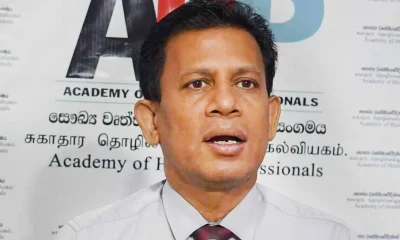
 News7 days ago
News7 days agoSuspension of Indian drug part of cover-up by NMRA: Academy of Health Professionals
-

 Sports5 days ago
Sports5 days agoChief selector’s remarks disappointing says Mickey Arthur
-
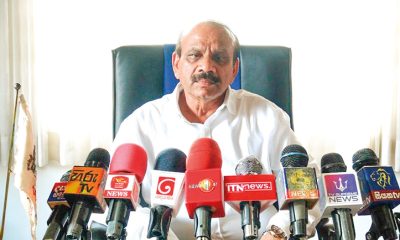
 News4 days ago
News4 days agoStreet vendors banned from Kandy City
-

 Editorial7 days ago
Editorial7 days agoA very sad day for the rule of law
-

 News7 days ago
News7 days agoUS Ambassador to Sri Lanka among 29 career diplomats recalled


